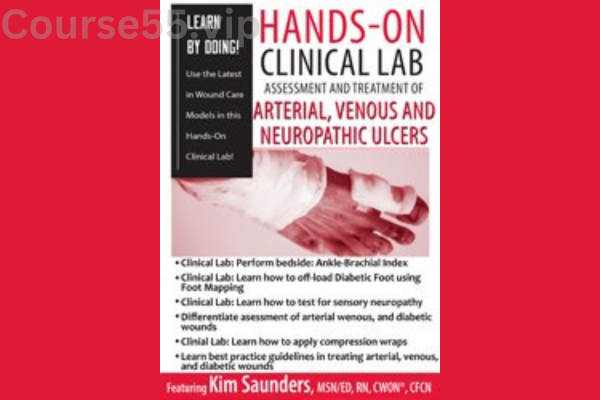Hands-On Clinical Lab: Assessment and Treatment of Arterial, Venous and Neuropathic Ulcers By Kim Saunders – PESI
$199.00 Original price was: $199.00.$23.10Current price is: $23.10.
Overview of Assessment and Treatment of Arterial, Venous, and Neuropathic Ulcers – Digital Download!

Hands-On Clinical Lab: Assessment and Treatment of Arterial, Venous and Neuropathic Ulcers By Kim Saunders – PESI
Overview

Assessment and Treatment Approaches for Arterial, Venous, and Neuropathic Ulcers
A comprehensive understanding of different ulcer types is fundamental in wound care to ensure effective treatment and favorable patient results. Clinical training that provides practical experience in evaluating and managing arterial, venous, and neuropathic ulcers is invaluable for medical professionals. Each category of ulcers has distinct attributes, underlying causes, and treatment protocols. By thoroughly analyzing arterial, venous, and neuropathic ulcers, clinicians can develop a well-rounded approach to assessment and therapy, ultimately enhancing patient care.
Identifying Arterial Ulcers
Arterial ulcers are primarily caused by poor circulation due to peripheral arterial disease (PAD), resulting in distinct, shallow wounds. These ulcers frequently develop on pressure-prone areas such as the toes and forefoot, presenting with a pale wound bed and minimal drainage. The restricted blood supply leads to tissue death, significantly delaying healing, making early detection essential.
Evaluation of arterial ulcers involves both physical examination and specialized diagnostic procedures. The Ankle-Brachial Index (ABI) is a key diagnostic measure that compares blood pressure in the ankle and arm, providing insight into arterial insufficiency. Additionally, Doppler ultrasound is utilized to assess blood flow and detect vascular narrowing.
Treatment for arterial ulcers prioritizes restoring proper circulation to the affected areas. Management strategies often include lifestyle modifications such as quitting smoking, implementing structured exercise routines, and improving dietary habits. Pharmacological approaches may involve prescribing antiplatelet medications or vasodilators. In cases where conservative measures are insufficient, surgical procedures such as angioplasty or bypass surgery may be required to enhance blood flow and promote healing.
Managing Venous Ulcers
In contrast, venous ulcers are a result of chronic venous insufficiency and account for a significant portion of lower limb ulcers. These wounds typically appear around the medial ankle and are characterized by irregular borders, a moist wound surface, and substantial drainage. The surrounding skin often exhibits pigmentation changes due to hemosiderin deposition and swelling, emphasizing the need for a thorough clinical evaluation.
Assessing venous ulcers involves reviewing the patient’s history of venous disorders and conducting a detailed leg examination. Duplex venous ultrasound plays a crucial role in identifying venous reflux and blockages, guiding appropriate treatment decisions.
The primary treatment approach for venous ulcers revolves around compression therapy, which facilitates blood return to the heart and minimizes swelling. Various compression options, such as bandages and medical-grade wraps, are employed to ensure adequate pressure and expedite healing. Additionally, addressing underlying venous conditions through procedures such as sclerotherapy or surgical interventions can further improve outcomes. Proper wound management, including selecting appropriate dressings and maintaining regular follow-up, is essential for optimal recovery.
Recognizing Neuropathic Ulcers
Neuropathic ulcers, which are most commonly observed in diabetic patients, develop due to a combination of sensory loss and abnormal foot biomechanics. These ulcers frequently emerge on high-pressure areas, particularly the sole of the foot, and present as round, well-defined wounds. Due to diminished sensation, patients may not notice these ulcers until they progress into severe complications.
Diagnosis of neuropathic ulcers includes a comprehensive foot examination alongside sensory tests to assess peripheral nerve function. The monofilament test, which evaluates pressure sensitivity, and the tuning fork test, which measures vibratory sensation, are essential tools in detecting neuropathy.
Effective treatment involves multiple strategies, with pressure offloading being a key component. Specialized footwear or orthotic devices are often used to reduce stress on affected areas. Additionally, maintaining optimal blood sugar levels is critical to supporting wound healing and preventing recurrence. Proper wound care, including routine cleaning and the use of suitable dressings, further contributes to tissue recovery and long-term skin integrity.
Comparing Ulcer Types
To provide a clearer understanding of the differences between arterial, venous, and neuropathic ulcers, the following table outlines their key characteristics, diagnostic methods, and treatment approaches:
| Ulcer Type | Characteristics | Assessment Methods | Treatment Approaches |
|---|---|---|---|
| Arterial | Defined edges, shallow depth, pale wound bed, minimal drainage | Ankle-Brachial Index (ABI), Doppler ultrasound | Lifestyle changes, medication, surgical revascularization |
| Venous | Irregular borders, excessive moisture, substantial drainage, skin discoloration | Duplex venous ultrasound | Compression therapy, wound management, venous intervention |
| Neuropathic | Well-circumscribed, round shape, frequently unnoticed, found on pressure points | Monofilament test, tuning fork test | Pressure relief, blood glucose control, wound care |
Clinical Guidelines and Best Practices
Ulcer management has significantly advanced with the integration of clinical research and standardized treatment protocols. Continuous review of medical literature and guidelines is essential to remain updated on the latest therapeutic advancements.
For example, studies highlight the effectiveness of multi-layer compression systems in accelerating healing for venous ulcers compared to traditional compression techniques. Additionally, the introduction of innovative wound dressings such as hydrocolloids and alginate-based materials has demonstrated superior wound healing properties by maintaining an optimal healing environment.
Recognizing the value of interdisciplinary care, many healthcare institutions have established wound care teams comprising physicians, nurses, nutritionists, and podiatrists. This collaborative approach has shown promising results, leading to faster healing rates, reduced infection risks, and higher patient satisfaction.
Conclusion
Inadequate ulcer management can lead to severe complications, underscoring the importance of accurate diagnosis and patient-specific treatment strategies. A solid understanding of arterial, venous, and neuropathic ulcers allows healthcare professionals to implement evidence-based practices that enhance patient outcomes. Remaining informed about ongoing clinical research and updated medical guidelines is crucial in refining treatment methodologies, ultimately improving the quality of life for individuals affected by these chronic wounds.
Frequently Asked Questions:
Business Model Innovation: We operate a group buying strategy, allowing participants to share costs and access popular courses at reduced prices. This model benefits individuals with limited financial resources, despite concerns from content creators about distribution methods.
Legal Considerations: The legality of our operations involves complex issues. Although we don’t have explicit permission from course creators to resell their content, there are no specific resale restrictions stated at the time of purchase. This ambiguity creates an opportunity for us to provide affordable educational resources.
Quality Control: We ensure that all course materials purchased are identical to those offered directly by the creators. However, it’s important to understand that we are not official providers. As such, our offerings do not include:
– Live coaching calls or sessions with the course author.
– Access to exclusive author-controlled groups or portals.
– Membership in private forums.
– Direct email support from the author or their team.
We aim to reduce the cost barrier in education by offering these courses independently, without the premium services available through official channels. We appreciate your understanding of our unique approach.
Be the first to review “Hands-On Clinical Lab: Assessment and Treatment of Arterial, Venous and Neuropathic Ulcers By Kim Saunders – PESI” Cancel reply
You must be logged in to post a review.

 Ultimate Guide Technical Trading
Ultimate Guide Technical Trading  Advances in Motor Control and Learning for Neurological Rehab By Ben Sidaway - PESI
Advances in Motor Control and Learning for Neurological Rehab By Ben Sidaway - PESI 














Reviews
There are no reviews yet.